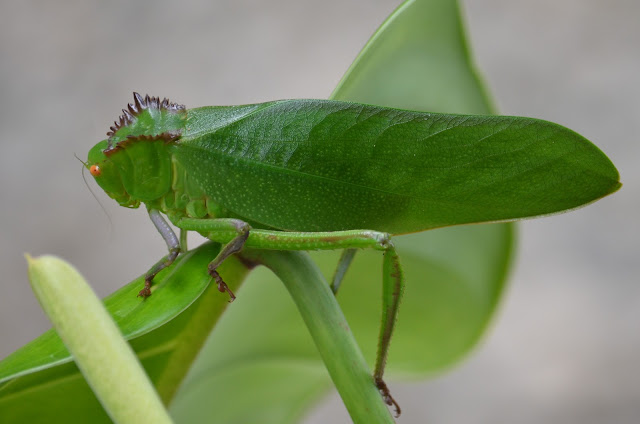With the Semana Santa holidays in Colombia came the opportunity to explore the region further. So my family and I headed for the Pacific Coast in Choco, staying at a small family run resort called Morromico on the edge of the Utria National Park, a 40min boat ride north of Nuqui. This place was a little slice of paradise with its own long black volcanic sand beach and bay backed by jungle-clad cliffs with crystal pure streams and waterfalls. We pretty much had the place to ourselves for the five nights we spent there and it was the perfect place to unwind and enjoy the sea and jungle.
 |
| The beach at Morromico |
Given its remote rain forest location, well away from roads or towns, Morromico was a great place for wild life. Our hosts at the resort also provided a couple of excellent guided walks into the jungle both by day and night, to find some of the harder to locate endemic species. A number of amphibians and reptiles could also be easily found within the grounds and by the beach. One of the most numerous lizards was the Western Basilisk, which frequented the steams and waterfalls emptying into the sand.. The many juveniles would escape when approached by running away across the water into the undergrowth.
%20Choco%20Colombia.JPG) |
| Basiliscus galeritus (Western Basilisk) Choco Colombia |
%20Choco%20Colombia%20(6).JPG) |
Basiliscus galeritus (Western Basilisk) Choco Colombia
|
Some of my favourite reptile and amphibian shots from the area around Morromico follow:
%20Choco%20Colombia%20-%20Copy.JPG) |
| Anolis purpurescens (Chocó purple anoles) Choco Colombia |
%20Choco%20Colombia%20(2).JPG) |
Anolis purpurescens (Chocó purple anoles) Choco Colombia
|
%20Choco%20Colombia%20(2).JPG) |
| Holcosus festivus ( Edward’s Middle American Ameiva) Choco Colombia |
%20Choco%20Colombia.JPG) |
| Leptodeira anulata (Brown Cat Snake) Choco Colombia |
%20Choco%20Colombia%20-%20Copy.JPG) |
| Echinosaura palmeri (Palmer's teiid) Choco Colombia |
%20-%20Copy.JPG) |
| Loxopholis southi Choco Colombia |
%20Choco%20Colombia.JPG) |
| Oxybelis aeneus (Brown Vinesnake) Choco Colombia |
%20Choco%20Colombia.JPG) |
| Oophaga solanensis (Bahia Solano Poison Frog) Choco Colombia |
%20Choco%20Colombia%20(2).JPG) |
| Oophaga solanensis (Bahia Solano Poison Frog) Choco Colombia |
%20Choco%20Colombia.JPG) |
| Cochranella euknemos (San Jose Glass Frog) Choco Colombia |
%20Choco%20Colombia%20(2).JPG) |
| Cochranella euknemos (San Jose Glass Frog) Choco Colombia. Lit from below to show transparency. |
%20Choco%20Colombia%20(2).JPG) |
Atelopus spurrelli (Choco Harlequin Toad) Choco Colombia
|
%20Choco%20Colombia.JPG) |
| Atelopus spurrelli male |
%20Choco%20Colombia%20(4).JPG) |
| Atelopus spurrelli female |
%20Choco%20Colombia%20(3).JPG) |
| Craugastor raniformis (Robber Frog) Choco Colombia |
%20Choco%20Colombia.JPG) |
| Pristimantis sp (Rain Frog) Choco Colombia |
%20Choco%20Colombia.JPG) |
| Rhinella horribilis (Pacific Cane Toad) Choco Colombia |
Part way through our stay we took a boat trip to spend the morning snorkelling at a small island called Playa Blanca, with a patch of coral and white sand, rare for the region. After lunch on the beach we took the boat across to the entrance of the Utria National Park, where we explored the mangroves via a raised walkway. The area was particularly rich in epiphytic plants including these bromeliads and orchids:
 |
Assorted Bromeliads
|
%20Choco%20Colombia.JPG) |
| Guzmania scherzeriana |
%20Choco%20Colombia.JPG) |
| Guzmania musaica |
 |
| Moulting Katydid Choco Colombia |
%20Choco%20Colombia%20(5).JPG) |
| Zammara smaragdula (Emerald Cicada) emerging |
%20Choco%20Colombia.JPG) |
| Zammara smaragdula (Emerald Cicada) |
In summary this part of Colombia is a wonderful unspoilt and wild contrast to the Caribean coast, much more wild and rugged and less tainted by mass tourism on account of its relative isolation. I hope that as it develops it manages to maintain what makes it special.
 |
| Morromico Beach |

%20Choco%20Colombia.JPG)
%20Choco%20Colombia%20-%20Copy.JPG)
%20Choco%20Colombia%20(2).JPG)
%20Choco%20Colombia%20(2).JPG)
%20Choco%20Colombia.JPG)
%20Choco%20Colombia%20-%20Copy.JPG)
%20-%20Copy.JPG)
%20Choco%20Colombia.JPG)
%20Choco%20Colombia.JPG)
%20Choco%20Colombia%20(2).JPG)
%20Choco%20Colombia.JPG)
%20Choco%20Colombia%20(2).JPG)
%20Choco%20Colombia%20(2).JPG)
%20Choco%20Colombia.JPG)
%20Choco%20Colombia%20(4).JPG)
%20Choco%20Colombia%20(3).JPG)
%20Choco%20Colombia.JPG)
%20Choco%20Colombia.JPG)

%20Choco%20Colombia.JPG)
%20Choco%20Colombia.JPG)


%20Choco%20Colombia%20(3).JPG)
%20Choco%20Colombia.JPG)


%20Choco%20Colombia%20(2).JPG)
%20Choco%20Colombia.JPG)
%20Choco%20Colombia.JPG)
%20Choco%20Colombia%20(2).JPG)




%20Choco%20Colombia%20(5).JPG)
%20Choco%20Colombia.JPG)

%20Choco%20Colombia%20(6).JPG)